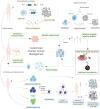Advancements in ovarian cancer immunodiagnostics and therapeutics via phage display technology
- PMID: 38863706
- PMCID: PMC11165035
- DOI: 10.3389/fimmu.2024.1402862
Advancements in ovarian cancer immunodiagnostics and therapeutics via phage display technology
Abstract
Ovarian cancer, ranking as the seventh most prevalent malignancy among women globally, faces significant challenges in diagnosis and therapeutic intervention. The difficulties in early detection are amplified by the limitations and inefficacies inherent in current screening methodologies, highlighting a pressing need for more efficacious diagnostic and treatment strategies. Phage display technology emerges as a pivotal innovation in this context, utilizing extensive phage-peptide libraries to identify ligands with specificity for cancer cell markers, thus enabling precision-targeted therapeutic strategies. This technology promises a paradigm shift in ovarian cancer management, concentrating on targeted drug delivery systems to improve treatment accuracy and efficacy while minimizing adverse effects. Through a meticulous review, this paper evaluates the revolutionary potential of phage display in enhancing ovarian cancer therapy, representing a significant advancement in combating this challenging disease. Phage display technology is heralded as an essential instrument for developing effective immunodiagnostic and therapeutic approaches in ovarian cancer, facilitating early detection, precision-targeted medication, and the implementation of customized treatment plans.
Keywords: immunodiagnostics; ovarian cancer; personalized therapeutic strategies; phage display technology; targeted drug delivery.
Copyright © 2024 Li, Li, Yang and Tong.
Conflict of interest statement
The authors declare that the research was conducted in the absence of any commercial or financial relationships that could be construed as a potential conflict of interest.
Figures






Similar articles
-
Preparation of Phage Display cDNA Libraries for Identifying Immunogenic Tumor Antigens: Challenges in Functional cDNA Presentation and Approaches to Overcoming Them.Viruses. 2024 Nov 29;16(12):1855. doi: 10.3390/v16121855. Viruses. 2024. PMID: 39772164 Free PMC article. Review.
-
In vitro high throughput phage display selection of ovarian cancer avid phage clones for near-infrared optical imaging.Comb Chem High Throughput Screen. 2014;17(10):859-67. doi: 10.2174/1386207317666141031152828. Comb Chem High Throughput Screen. 2014. PMID: 25360673
-
Tumor-Targeting Peptides Search Strategy for the Delivery of Therapeutic and Diagnostic Molecules to Tumor Cells.Int J Mol Sci. 2020 Dec 30;22(1):314. doi: 10.3390/ijms22010314. Int J Mol Sci. 2020. PMID: 33396774 Free PMC article.
-
Empowering Healthcare with Phage Display Technology.ACS Biomater Sci Eng. 2025 Jun 9;11(6):3228-3248. doi: 10.1021/acsbiomaterials.5c00218. Epub 2025 May 5. ACS Biomater Sci Eng. 2025. PMID: 40321044 Review.
-
Phage display screening identifies a novel peptide to suppress ovarian cancer cells in vitro and in vivo in mouse models.BMC Cancer. 2015 Nov 10;15:889. doi: 10.1186/s12885-015-1891-8. BMC Cancer. 2015. PMID: 26555399 Free PMC article.
Cited by
-
Interleukin-1β Inhibits Ovarian Cancer Cell Proliferation and Metastasis Through the MAPK/MMP12 Pathway.Int J Mol Sci. 2025 Apr 1;26(7):3287. doi: 10.3390/ijms26073287. Int J Mol Sci. 2025. PMID: 40244135 Free PMC article.
References
Publication types
MeSH terms
Substances
LinkOut - more resources
Full Text Sources
Medical

